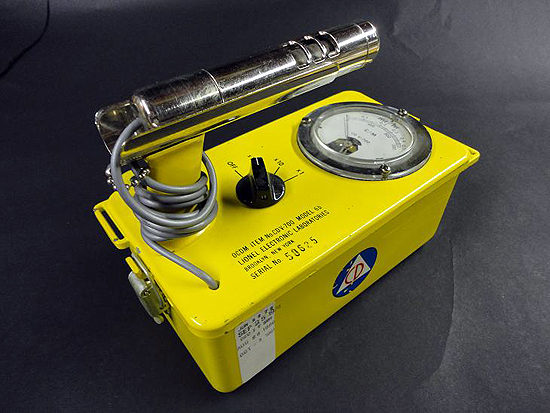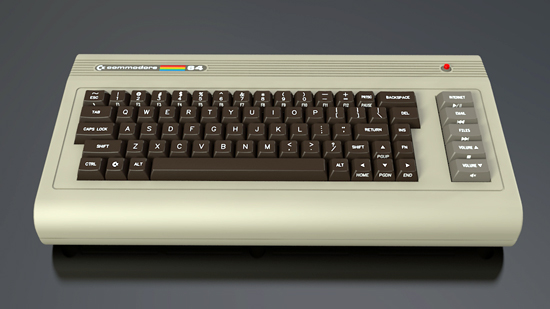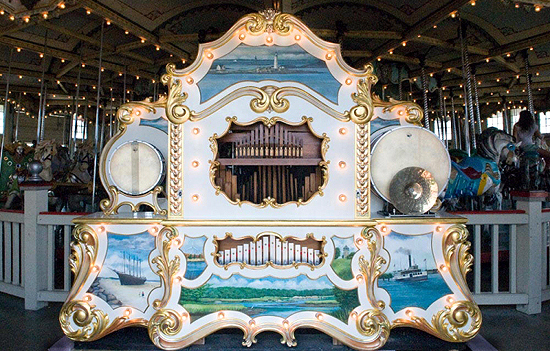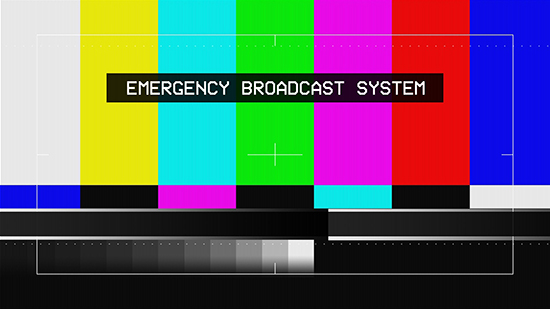|
“Sonic Simulations” (1990) Audio CD, edition of 500. Introduction |
| “Sonic Simulations” is a computer-generated audio work inspired by the writings of Jean Baudrillard in Simulations (Semiotexte, New York, 1983). Composed of five short pieces, the work treats the organization of sound as a self-referential phenomenon that can be deployed as a musical surrogate -- to occupy a space where music might otherwise go. One aspect of the work explores the social applications of fundamental periodic sounds including the sine and square waves. These sounds are ingrained in my earliest childhood memories, from watching the Apollo 11 moon landing on television to receiving a hearing test in grade school. |
Robert Zott |
|
| “Interference (for Geiger Counters)” is orchestrated with a digital sample of the radioactive decay of a Cesium 137 atom, as detected by a Civil Defense Geiger Counter. The sample is repeated in a precession of meters that serve as a rhythmic model. A sine wave is used to partition the work in a manner similar to the one-way transmission signals used by NASA to communicate with astronauts. |
|
| “Amerikan Horns” is a sonic rendering of a scene in the Franz Kafka novel “Amerika” where each member of his Nature Theatre of Oklahoma randomly blasts on a uniquely fashioned horn. The chaos of the scene is controlled by a construct that relates the pitch, amplitude, and duration of each musical event to a single arbitrary constant. See Parametric Unity. |
|
| “Twinkle Twinkle Compressed” takes the melody of the famous lullaby and compresses it into 15/100ths of a second. The piece was programmed directly into machine code using a Commodore 64 computer in order to reach the intense speed. The work begins with a countdown similar to the repeated square wave used by trucks to signal when they’re moving in reverse and culminates in an explosion caused by the imperceptibly fast melody. |
|
| “Homage to Schoenberg” is an exact digital recreation of “The Merry Go Round Broke Down,” also known as the Merry Melodies theme song. It was chosen as a metaphor for the breakdown of serialism. For this piece, the computer -- a device capable of performing music beyond human limitations – was programmed to behave like a mechanical band organ. |
|
| Finally, in “Two Tests,” the sine wave is used to recreate the Emergency Broadcast System (EBS) test and a hearing test based on pure tone audiometry. The EBS test uses a fixed pair of frequencies (853 and 960 Hz) at an arbitrary amplitude for a fixed duration – in this case, 60 seconds. The hearing test uses an arbitrary set of pitches, amplitudes, and durations. |
|
|
|
| I consider Sonic Simulations to be my first finished work in any medium, so it has a lot of great memories attached. It was a time of cheap student living and minimal possessions, but I burned for it; I was on a mission! Production began in 1988 and the CD was released in 1990. The copyright is listed here. The CD was pressed by a company called American Helix in Lancaster, PA back when duplication involved clean rooms and Oompa-Loompa suits. It would have been finished sooner, but the initial pressing had a skip in the glass master, so they all had to be returned, new CDs had to be made, and the old shrink-wrapped CDs torn down so the jewel cases could be re-used. |
|
| I created the insert graphics myself on a first-generation Macintosh computer using early versions of PageMaker and Illustrator that fit on a single 3.5-inch diskette, each. I had them printed and scored locally, sent them to American Helix, and prayed to the printing gods that the j-cards would fit. Luckily, they did. The minimum run was 500, minus a few defects for a total of 484 discs. |
|
| I graduated from SUNY Albany in 1988 with a degree in physics, but I had studied computer music with Joel Chadabe since I arrived in 1985. In addition to his own ground-breaking work, Joel was a mentor and a great benefactor who welcomed me at the SUNY studio long after my enrollment ended. When I first arrived, his famous modular synth, hand-built by Robert Moog, was in complete disrepair and would eventually be packed up and shipped off to a museum in Scandinavia. An original Macintosh had just arrived, and we began playing with pre-launch versions of “M” -- the first product of his latest venture: Intelligent Computer Music Systems. |
|
|
Immediately upon graduation, I made an ill-fated move to Philadelphia. I was nearly broke and unemployed, and I arrived during one of the worst heat waves in the city’s history. To keep cool, I would visit The Philadelphia Museum of Art, and that’s where I first saw the painting “Amerika VII” by Tim Rollins and K.O.S. [Kids of Survival]. Inspired by Kafka’s unfinished novel “Amerika,” the painting was composed of golden horns twisted into bizarre abstract and representational designs, giving form to the sense of individuality described in a chapter entitled “The Nature Theatre of Oklahoma.” The horns were literally painted over the physical pages of the book that were pasted onto the canvas as a ground. I was blown away. I *had to* hear them! I imagined all of America lighting up in a conflagration of sound. Back at my sweaty apartment, I set up my Commodore 64 -- the only thing I had that generated sound -- and created a sketch for Amerikan Horns. It was monophonic and only around 30 lines of Basic code, but it was remarkably close to the finished recording that was realized on much more sophisticated equipment. I lasted about three weeks in Philly before my money ran out, then I returned to Albany and slept on friends’ couches. Eventually, I managed to get a job at a quick-print shop based on spending 10 minutes in the SUNY studio fiddling with MacPaint, and would spend the next two years creating Sonic Simulations in my free time. |
|
|
I discovered computer music in 1981 during my senior year of high school when I saw the single word “programming” -- spelled the British way -- in the cassette liner notes of Peter Gabriel’s third solo album known anecdotally as “Melt.” It referred to the Fairlight Computer Musical Instrument, and I eventually discovered that Fairlight had an office in NYC -- I grew up a train ride away on Long Island. I showed up unannounced at their tiny office in a skyscraper in midtown that was virtually empty except for a Fairlight, and it was there that I met Clive Smith, who graciously gave an 18-year-old kid a demo of an instrument only the top studios and professionals could afford. I remain forever grateful, and the brochure he gave me fueled dreams of gaining access to such an instrument for years to come. After an analog electronic music class at Boston University in 1983, I had the opportunity to become an exchange student at The MIT Media Lab on their PDP-11 system. It was a dream come true to attend lectures by Barry Vercoe, Max Mathews, Jean-Claude Risset, and Manfred Clynes. But as far as creating music goes, I floundered miserably and realized that while I was given access to then state-of-the-art equipment, in truth, I had nothing to say. I left the lab, crushed. Back at my very cold room in an Allston boarding house, I began to sketch Fourier Transforms on paper, thinking about the energy used to generate them, and wondering if that energy could be used as a compositional generator like a tone row. By ’86 I had worked out my compositional construct while studying with Neil Rolnick at the Integrated Electronic Arts at Rensselaer (iEAR) Studios of The Rensselaer Polytechnic Institute (RPI). Joel arranged for me to spend a year with Neil on RPI’s Synclavier II -- yet another example of Joel’s beneficence. [Joel owned the Synclavier prototype.] Since I was now an exchange student at RPI and time on the Synclavier was in high demand, my studio time was often at 2:00 or 3:00 in the morning, and commuting to RPI from downtown Albany involved taking the last 22 bus at midnight to Troy. I was definitely on a mission! The first composition I made on the Synclavier using the construct was called “Mass 1: Sonic Construction,” programmed in New England Digital’s version of XPL. It was a pure composition made with sine waves in 12 TET, and only recorded on cassette. I liked the double entendre of “mass” as both a sacred ritual and physical property. I would later expand this piece to a Frequency Modulated version that I performed at RPI, but it wasn’t recorded and the dense timbres were difficult to control. With this experience, by the time I got to Philadelphia, making the sketch for Amerikan Horns was relatively straight forward. It would take another 30+ years to work out the details described in Parametric Unity. Even now, I consider it more a manifesto than a music theory. There are parts that are deliberately vague and dream-like; academic journals wanted me to clean up these ambiguities, but I refused. Compositional ideas should be open to interpretation! Like Kafka’s “Amerika,” there’s beauty in the incomplete. |
|
| Concurrent with my time at RPI, I had a menial work-study job at the SUNY Albany Art Department 35mm Slide Library. To stave off the boredom, I would read the art magazines and the class notes of the adjunct professors that were kept in the library for reference. Little did I know that Ronald Jones was a faculty member in residence that semester, a rising star in the art world who showed at Metro Pictures in NYC. That exposure opened up the entire world of contemporary art for me. On a semester break, I took an Amtrak train to Soho, NYC and bought an armful of books that were referenced in the magazines: Baudrillard’s “Simulations,” Paul Virilio’s “Speed and Politics,” Peter Halley’s “Collected Essays,” etc. While the ideas presented in Simulations served as a basis for the Neo Geo movement in visual art, I wondered how they might be applied to sound. |
|
|
Distribution was a wasteland in 1990, especially for something as abstract and obtuse as Sonic Simulations. There was simply nothing to relate it to. Most electronic music that I knew was on the big labels: Nonesuch or Deutsche Grammophon. So, I tried marketing the CD as experimental sound in the context of fine art, similar to Christian Marclay or Max Neuhaus. I bought a copy of the Flash Art Directory, an insider’s address book for practically everyone in the art world, and I sent out about 40 free copies to try to generate some buzz. I sent them to galleries and visual artists I admired including Jeff Koons, Julian Schnabel, and Richard Prince, as well as crossover artist/musicians like Laurie Anderson, Meredith Monk, and Yoko Ono. As for retail, the CD was accepted by Printed Matter Bookstore in NYC, which deserves my eternal gratitude for still having the last of their 5 copies available for sale when I checked last year. Now, *that* is persistance! ... Finally, I bought a quarter page ad in Flash Art International Magazine for $1,200 -- a huge sum in those days. The upshot: No buzz was generated, a few copies were sold through Printed Matter, and the ad elicited no response whatsoever. To date, I’ve sold or given away about half of the CDs. |
|
|
The Gear |
|
The SUNY studio had a very simple hardware setup, but quite sophisticated for its time; it had a Mac, a full-sized keyboard controller, an Emu Emax rack-mounted sampler and two rack-mounted Yamaha TX-81Zs. For software, we had an Opcode Sequencer, beta and early release versions of M and Jam Factory, and Laurie Spiegel’s Music Mouse. Interference (for Geiger Counters) is a sampled Civil Defense Geiger Counter with a Cesium-137 source. The sample was looped at a rate proportional to the chosen note on the controller and performed live. The sine wave beeps inspired by Apollo 11 transmission signals were made with one of the TX-81Zs. These beeps were used in Two Tests, as well. Amerikan Horns used a horn preset on the Emax. I programmed the Mac in Basic to generate MIDI code that was compiled -- not in real time. Sadly, the Emax was stolen from the studio during production, and the recording was made with the most gracious assistance of the late Richard Lainhart, who had the same setup in his home studio. For Twinkle Twinkle Compressed, I programmed the melody in machine code on the Commodore 64 and played it faster and faster, until it achieved a speed of about 15/100ths of a second. I then sent the pulse through an Alesis Microverb. The 10-beep countdown at the beginning was a series of square waves. Homage to Schoenberg is a mechanistic recreation of “The Merry-Go-Round Broke Down” a.k.a. The Bugs Bunny Theme Song, made with an Opcode Sequencer. The instruments are all Emax presets except for the tuba-like bass, created with the TX-81Zs in stereo to achieve better resonance in the bottom end. Two Tests consisted of the two TX-81Zs, first tuned to the frequencies of the Emergency Broadcast System (EBS) Test, then played at random frequencies, amplitudes, and durations in a manner that mimics pure-tone audiometry. Each piece on Sonic Simulations was recorded with a Nakamichi DMP-100 Digital Mastering Processor, the first commercially available analog-to-digital converter that worked with a SONY Betamax VCR. The recordings were made by James McLean, who would later become the sound engineer at The Knitting Factory in NYC. The separate pieces were then transferred to Digital Audio Tape [Once it was invented!] by Ray Rettig and Bob Irwin at Cotton Hill Recording Studio in Albany, from which a 1630 Master was created by Dr. Toby Mountain at Northeastern Digital Recording, a wild studio camouflaged as a bungalow in suburban Shrewsbury, MA. |
|
| When performing live, I would always start with Two Tests triggered automatically on a timer, and watch from backstage to see if the audience members laughed and started raising their hands according to the location of the sound. If they did, I knew they’d be receptive to what I was about to perform. The greatest compliment I’ve ever received about Sonic Simulations came after a performance at the SUNY Albany Performing Arts Center when an audience member said “It’s not really music, is it?” I’ve used this phrase as a guide, ever since. |
|
|
My one regret about the construct was that I never pushed it to its logical limit. Despite the possibilities of a completely variable musical architecture, American Horns is still in 12 TET. This may have been a MIDI limitation at the time. I experimented with 19 TET on the Synclavier, but ultimately settled back on 12. At the time of this writing I have just completed “THE BIRTH of MVSIC”: a short audio work with video. Like Dorothy in The Wizard of Oz who learned that there’s no place like home, I’ve created what is perhaps my ultimate work on the Commodore 64. It’s a compendium of all my sound experiments for the C64 with echoes of Sonic Simulations heard throughout. The sections made with the construct are in infinite TET with a completely variable musical architecture: any frequency, any amplitude, any duration, limited only by the construct and the physical constraints of the instrument. Here’s the setup: |
|
E-mail: robertzott@comcast.net |
For the latest news, follow Robert Zott on Instagram. |
|
|



